Reviews
The Big-Budget Sharjah Biennial Tackles Postcolonial Fallout With Beauty, Sentimentality, and Nuance
The exhibition is a homage to the late curator Okwui Enwezor who began planning it before his untimely death.
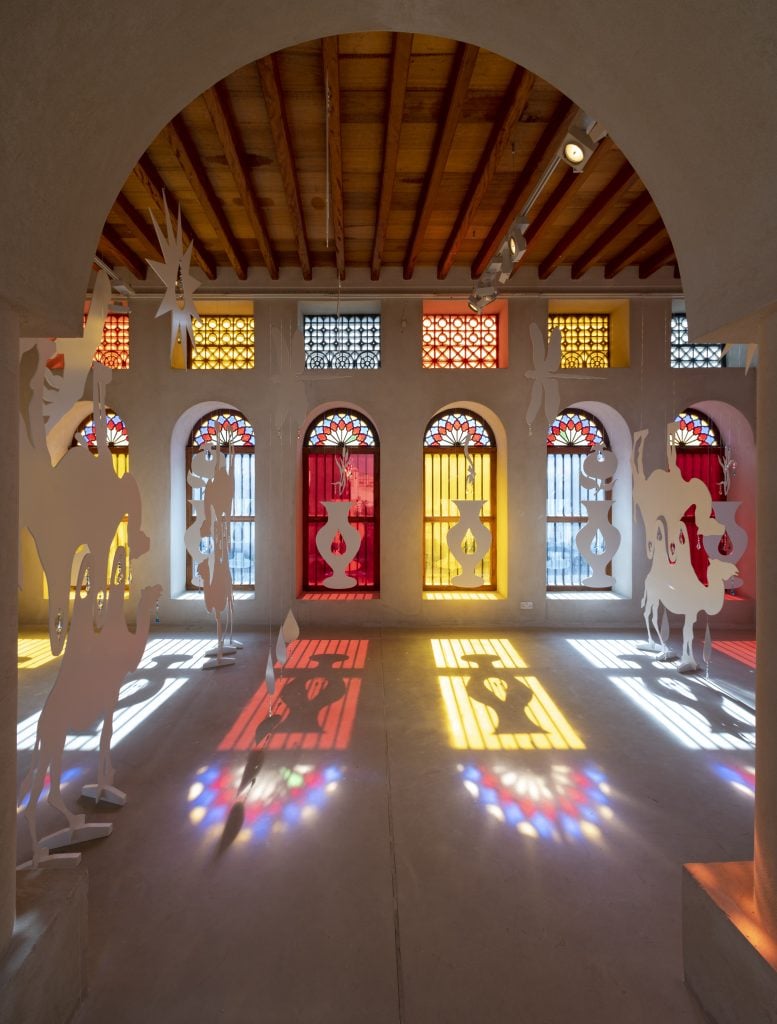
The exhibition is a homage to the late curator Okwui Enwezor who began planning it before his untimely death.

Janelle Zara

In Billy Sings Amazing Grace (2013), Theaster Gates, renowned archivist and lesser-known vocalist, wails and croons in a darkened auditorium alongside the white-haired and stoic soul singer Billy Forston. In its profound sonic resonance, their video performance of improvisational gospel is one of many highlights in “Thinking Historically in the Present,” the recently opened 15th edition of the Sharjah Biennial.
Like the show as a whole, the piece is a work of intimate, visceral storytelling, in both mournful and celebratory turns. Featuring about 300 works from more than 150 artists and collectives, including 70 new commissions, the excellent “Thinking Historically” is biennial director Hoor Al Qasimi’s homage to the late and well-loved Okwui Enwezor, who was originally appointed curator before his passing in 2019.
In her catalog essay, Al Qasimi reflects on Enwezor’s groundbreaking decolonial legacy, citing his 2002 approach to Documenta 11 as “a lodestar in my curatorial consciousness.” Validating artists outside the canon’s narrow purview, his work had offered her a glimpse into a wider world of possibilities, unhindered by “the social myopia” of Eurocentrism.
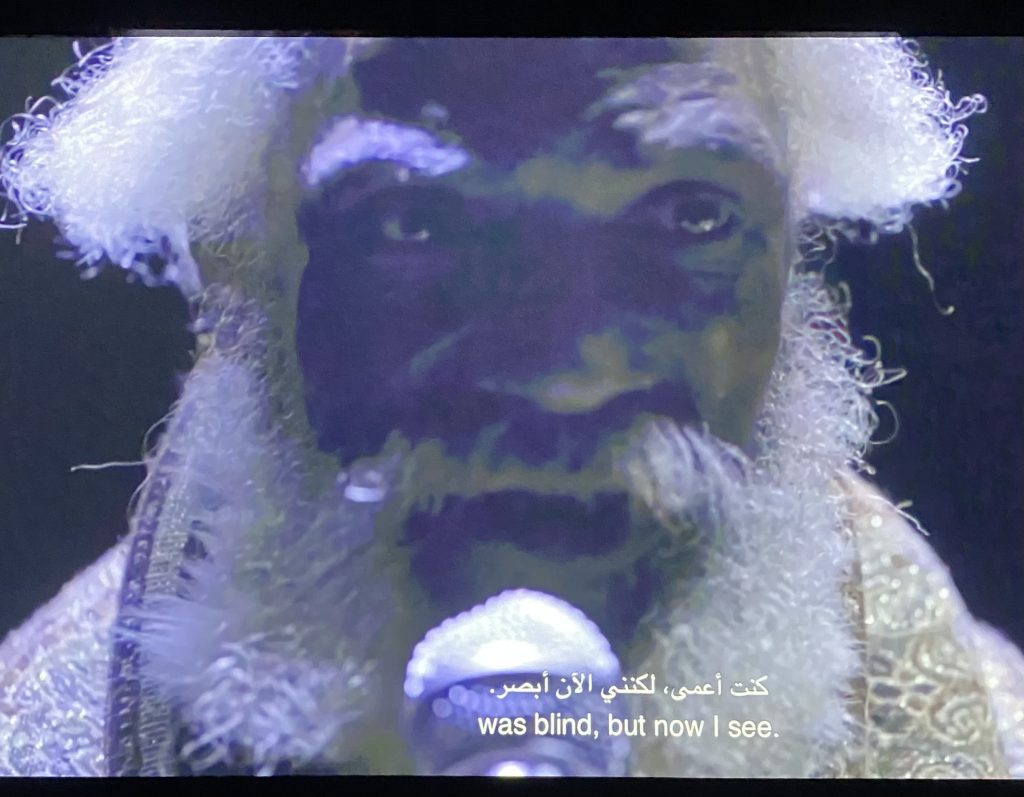
Theaster Gates’s Billy Sings Amazing Grace (2013). Photo: Janelle Zara
Nodding to Enwezor’s decentralization of Documenta 11 across five cities, the Sharjah Biennial spans five towns across the emirate, in venues that include the polished galleries of the capital city, and the peeling classrooms of a disused kindergarten along the coast.
A full generation since Enwezor’s groundbreaking exhibition in Germany, the participating biennial artists contend with what are now-familiar themes: the aftermath of empire, foreign extraction, and slavery among others.
“Thinking Historically” is a welcome antidote to the academic tropes of recent biennials, some of which, like the Berlin and Istanbul Biennials in 2022, were filled with research-based projects with few formal merits. In the rich textures of works like Ibrahim Mahama’s monumental tapestry, A Tale of Time/Purple Republic (2023), or the gnarled, blackened branches of Doris Salcedo’s Uprooted (2020-2022), form is the defining feature, not an afterthought in service to a predetermined message. (Their scale, which is grand, also indicates just how well-funded this biennial is.)
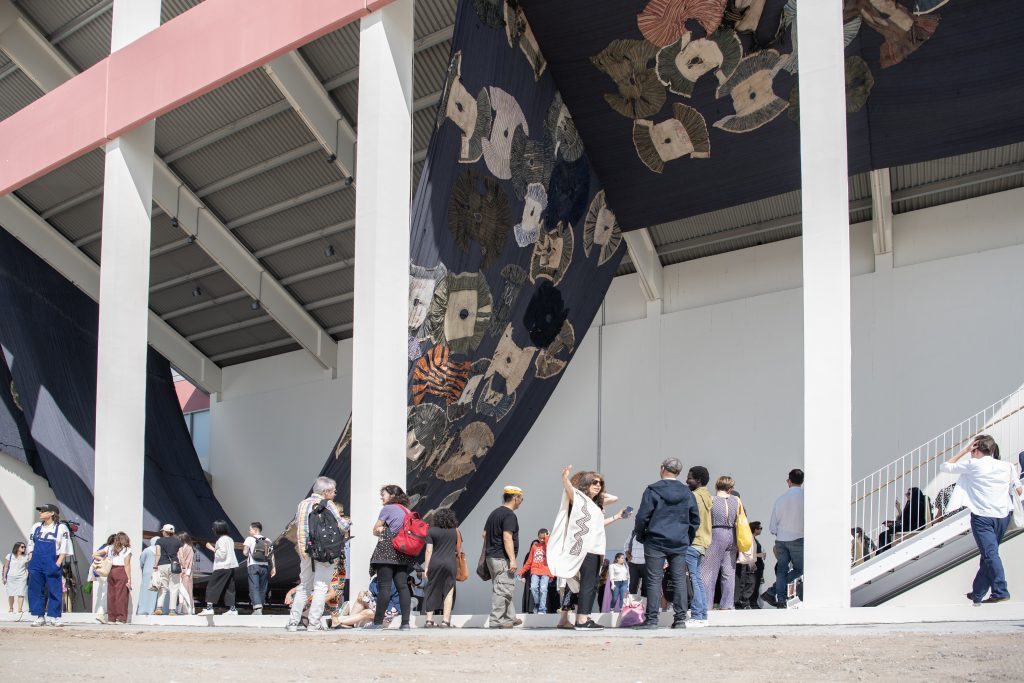
Ibrahim Mahama’s A Tale of Time/ Purple Republic (2023) Installation view: Sharjah Biennial 15, Kalba Ice Factory (2023). Commissioned by Sharjah Art Foundation. Photo: Motaz Mawid
Like many biennials, Sharjah’s exhibition is video-heavy, ranging from the heart-wrenching simplicity of Erkan Özgen’s Wonderland (2016), a searing account of the Syrian Civil War, to the sumptuousness of Isaac Julien’s immersive black-and-white cinematic installation, Once Again… (Statues Never Die) (2022). The show’s weaknesses lie in concept-forward paintings that suffer from a lackluster handling of paint, or photographs of state-inflicted strife that rest too comfortably in a photojournalistic lane. There is notably little, if any work that directly addresses Emirati exploitation of migrant labor.
Yinka Shonibare’s Decolonised Structures (2022), a series of British imperial statues cloaked in the Dutch wax patterns of West African fabrics, succinctly captures the limits of a now-rote approach to dismantling the West. While its cosmetic intervention sits on the surface, the colonial legacy remains underneath, whole and untouched.
Other artists have moved beyond centering the colonizer, aspiring to deeper points of introspection. In Nosferasta (2022), a comically absurd and brilliantly acted 32-minute feature, artists Adam Khalil, Bayley Sweitzer, and the Rastafarian musician Oba frame colonization as a profoundly internalized malady, frequently perpetuated by the colonized themselves. For their Rastafarian protagonist, colonization is akin to vampirism, and Christopher Columbus is a literal vampire. The true villain of this story, however, is the fraught pursuit of assimilation.
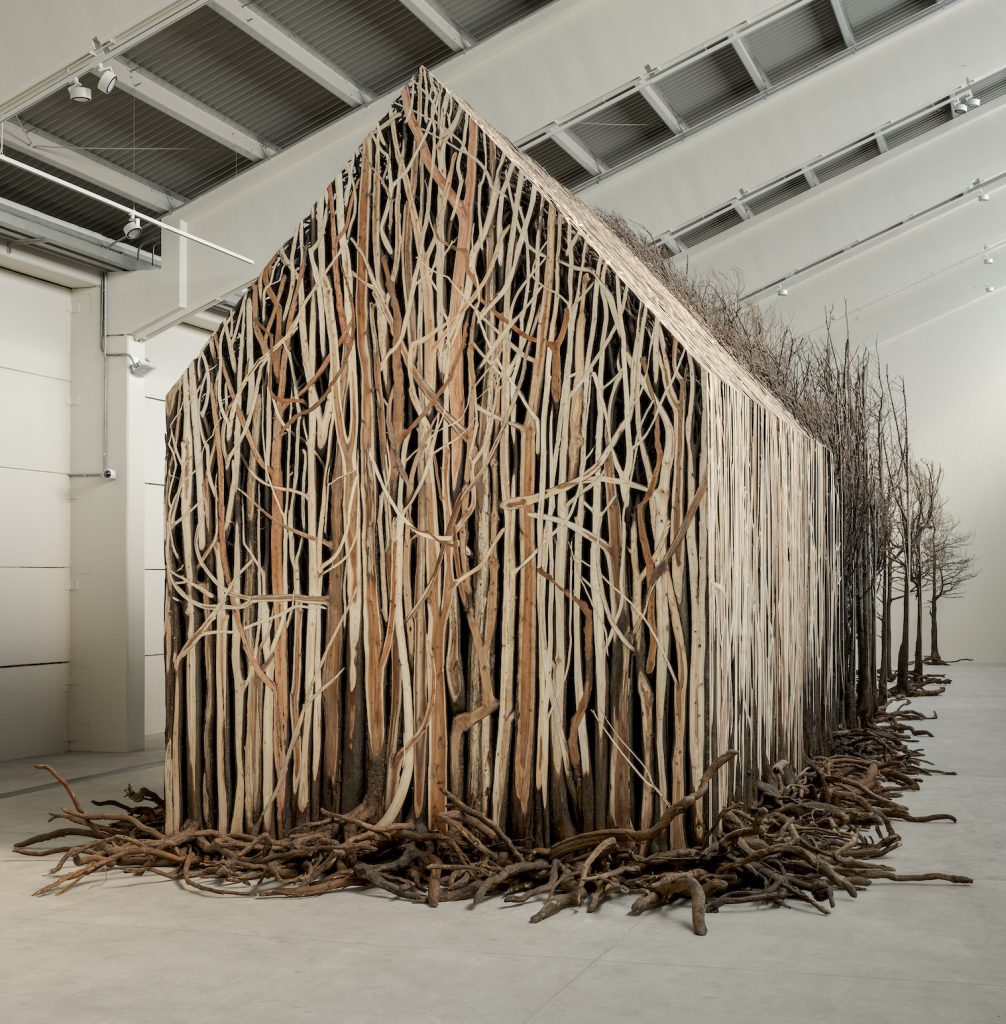
Doris Salcedo’s Uprooted (2020-2022). Courtesy of the artist. Photo: Juan Castro Photoholic
The assimilation theme recurs in various acts of self-erasure, including the portrait series Léthé (2021), in which photographer Mama-Diarra Niang beguilingly dissolves her subjects’ distinguishing features into a smooth, faintly recognizable haze.
In the video As British as a Watermelon (2019), Zimbabwean-born, British-based artist mandla rae shares shamed confessions, including the origins of scars both physical and mental, and the self-erasure of mispronouncing one’s name for European ears. “How colonized do you have to be to look at an African baby and call it Bridget?” they ask, handling the titular fruit with alternating tenderness and disquieting brutality.
Echoing Al Qasimi’s commemorative sentiments, homages to beloved predecessors abound, in monuments and imaginary museums, or Isaac Julien’s protagonist, captivatingly written as a composite of philosopher Alain LeRoy Locke and literary heroes Langston Hughes, Aimé Césaire, and James Baldwin. Throughout, the refusal of erasure amounts to asserting one’s place in history; it is honoring lineage, especially the legacies that the official record elides.
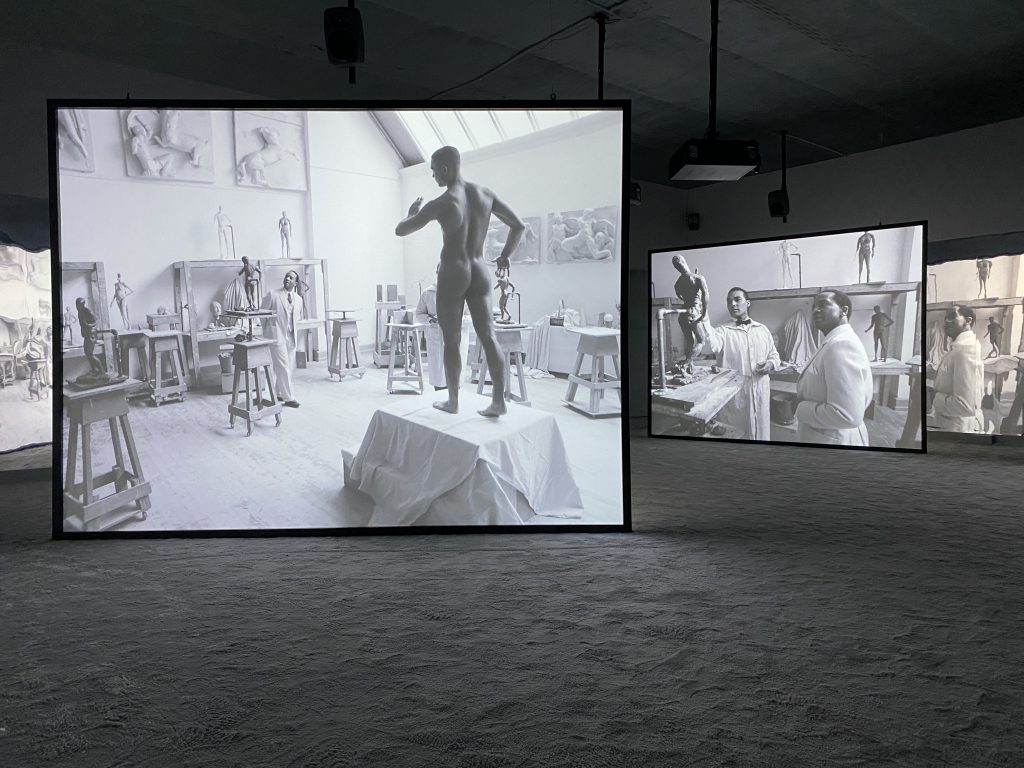
Isaac Julien’s Once Again… (Statues Never Die) (2022). Photo: Janelle Zara
Gabriela Golder’s surprisingly charming Conversation Piece (2012) is ostensibly a tribute to the artist’s mother, veiled in the cool irony of two 10-year-olds reading The Communist Manifesto. “What does the bourgeoisie have to do with the discovery of America?” they ask their grandmother, Golder’s mother and former militant of the Argentine Communist Party. Her response exudes a commanding wisdom as she gently and convincingly dismantles the myth of discovery.
These works stop just short of excessive sentimentality, arguably the Sharjah Biennial’s most compelling feature. Sentimentality eschews drier forms of institutional critique, which lately feel expressly designed as punitive history lessons for white audiences. Rather than attempt to solve the ills wrought by centuries of empire, artists here lean into art-making as a restorative, generative process, one more adept at asking questions than answering them.
My personal favorite works tap into spiritual traditions, as in Gates’ wailing hymnal, or Carrie Mae Weems’ The In Between (2022-2023), a shrine that features a small library of Enwezor’s books and a vessel that appears to sail into the afterlife. Michael Rakowitz’s Borrowed Landscape (30.3193 ° N, 48.2543 ° E) (2023) was ostensibly a large-scale, loose reinterpretation of the Passover Seder, performed in a dust-blown field of decapitated palms in the desert town of Al Dhaid.
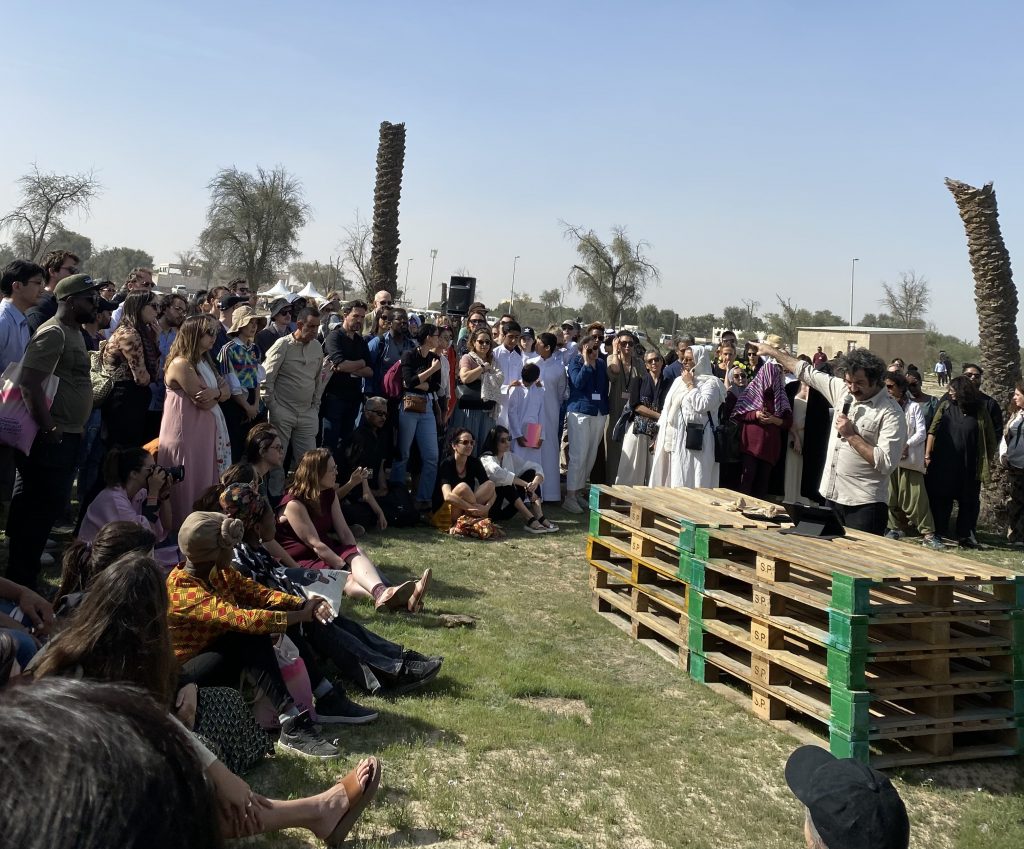
Michael Rakowitz’s Borrowed Landscape (30.3193 ° N, 48.2543 ° E) (2023). Photo: Janelle Zara
As Rakowitz read from an iPad to a crowd of several hundred people, he passed around objects culled from eBay that recalled the long-lost belongings of his family. Its simplicity was decidedly polarizing, but the performance struck me as a moving dedication to histories one can no longer access. The title’s coordinates refer to a site in Iraq where his family’s date trees stand similarly mangled as the palms that surrounded us.
The artist designated this site as “a place to contemplate another,” speaking of the hyphen as metaphor, a suture between disparate points, but also between the “irreconcilable binaries” of his identity as an Iraqi Arab-Jew. He ended the piece with the biblical task of supplying an enormous crowd with roasted fish—masgouf, a national Iraqi dish dating back 3,000 years. When denied the right to return, to speak one’s history aloud and to share it with others is what keeps it alive.
The Sharjah Biennial is on view until June 11, 2023.